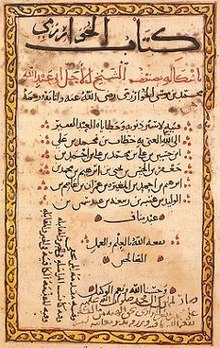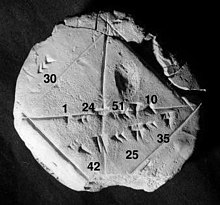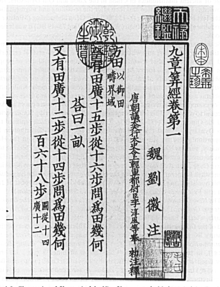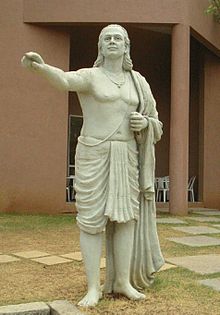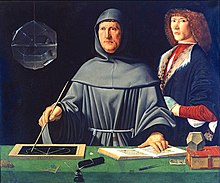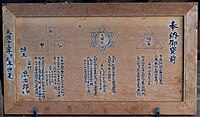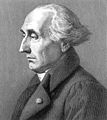History of mathematics
The history of mathematics is the area of study of research on the origins of discoveries in mathematics, of the methods of the evolution of its concepts and also, to a certain degree, of the mathematicians involved. The emergence of mathematics in human history is closely related to the development of the concept of number, a process that occurred very gradually in early human communities. Although they had some ability to estimate sizes and magnitudes, they did not initially have a notion of number. Thus, the numbers beyond two or three, had no name, so they used some expression equivalent to "many" to refer to a larger set.
The next step in this development is the appearance of something close to a concept of number, albeit very basic, not yet as an abstract entity, but as a property or attribute of a concrete set. Later, the advance in complexity of the social structure and its relationships was reflected in the development of mathematics. The problems to be solved became more difficult and it was no longer enough, as in primitive communities, to just count things and communicate to others the cardinality of the counted set, but it became crucial to count larger and larger sets, quantify time, operate with dates, enable the calculation of equivalences for barter. It is the moment of the emergence of numerical names and symbols.
Before the modern age and the spread of knowledge throughout the world, written examples of new mathematical developments came to light in only a few settings. The oldest available mathematical texts are the clay tablet Plimpton 322 (c. 1900 BC), the Moscow Papyrus (c. 1850 BC), the Rhind Papyrus (c. 1650 BCE) and the Vedic texts Shulba Sutras (c. 800 BCE).
Traditionally it has been considered that mathematics, as a science, arose in order to make calculations in commerce, to measure the Earth and to predict astronomical events. These three needs can be related in some way to the broad subdivision of mathematics into the study of structure, space, and change.[citation needed]
Egyptian and Babylonian mathematics were broadly developed by Hellenic mathematics, where methods were refined (especially the introduction of mathematical rigor in proofs) and the issues of this science were expanded. Mathematics in medieval Islam, in turn, it developed and extended the mathematics known to these ancient civilizations. Many Greek and Arabic mathematical texts were translated into Latin, which led to the further development of mathematics in the Middle Ages. Since the Italian Renaissance, in the 15th century, new mathematical developments, interacting with contemporary scientific discoveries, have grown exponentially until the present day.
Prehistory
Long before the earliest written records, there are drawings that indicate some knowledge of elementary mathematics and star-based measurement of time. For example, paleontologists have discovered ocher rocks in Blombos Cave in South Africa that are approximately 70,000 years old, which are adorned with indentations in the form of geometric patterns. Prehistoric artifacts have also been discovered in Africa and France, dating to between 35,000 AD. and 20,000 B.C. C., which suggest early attempts to quantify time.
There is evidence that women invented a way to keep track of their menstrual cycle: 28 to 30 marks on a bone or stone, followed by a distinctive mark. Furthermore, hunters and herders used the concepts of one, two and many, as well as the idea of none. > or zero, when speaking of herds of animals. The Ishango bone, found near the Nile River in northeastern Congo, may date to before 20,000 BC. C. A common interpretation is that the bone is the earliest known demonstration of a sequence of prime numbers and of multiplication by doubling.
Old Age
Babylon
Babylonian mathematics (also known as Assyrian-Babylonian mathematics) is the whole of mathematical knowledge developed by the peoples of Mesopotamia, present Iraq, from early submersive civilization to the fall of Babylon in 539 a. C. They are called Babylonian mathematics due to the central role of Babylon as a place of study, which ceased to exist during the Hellenistic period. From this point, Babylonian mathematics merged with Greek and Egyptian mathematics to give rise to Hellenistic mathematics. Later, under the Arab Empire, Mesopotamia, especially Baghdad, became an important study centre for Islamic mathematics.
The texts of Babylonian mathematics are abundant and well edited; they can be classified in two temporary periods: the one referring to the Ancient Babylon (1830-1531 B.C.) and the one corresponding to the seleucid of the last three or four centuries B.C. In terms of content, there are hardly any differences between the two groups of texts. Babylonian mathematics remained constant, in character and content, for approximately two millennia. In contrast to the few sources of Egyptian mathematics, our knowledge of Babylonian mathematics is derived from about 400 clay tablets, unearthed in 1850. Traced in cuneiform writing, the tablets were recorded while the clay was wet, and then hardened in an oven or warming them in the sun.
The earliest evidence of written mathematics dates from the ancient Sumerians, which constituted the primordial civilization in Mesopotamia. Sumerians developed a complex system of metrology from 3000 to C. From around 2500 B.C. onwards, the Sumerians wrote tables of multiplying on clay tablets and treated geometric exercises and division problems. The earliest signs of Babylonian numerals also date from that period.
Most of the recovered clay tablets date from 1800 to 1600 B.C. and cover topicals including fractions, algebra, quadratic and cubic equations and the calculation of reciprocal regular twin cousins (C.)See Plimpton 322). Tabs also include multiplication tables and methods to resolve linear equations and quadratic equations. The Babylonian tablet YBC 7289 gives an approximation of Ã2 with a accuracy of five decimal positions. Also mathematics encompasses many branches starting with the classification of numbers. Babylonian mathematics were written using a sexagesimal numbering system (base 60). Hence the division of one minute in 60 seconds and one hour in 60 minutes, as well as that of a circle in 360 (60 × 6) degrees and the sexagesimal subdivisions of this unit of measuring angles in minutes and seconds. The Babylonian advances in mathematics were facilitated by the fact that the number 60 has many divisors. Also, unlike the Egyptians, Greeks and Romans, the Babylonians had a real system of positional numbering, where the digits written on the left represented higher order values, as in our current decimal numbering system. However, they lacked a decimal comma equivalent and thus the true value of a symbol should be deduced from the context.Egypt
Egyptian mathematics is the mathematics developed in Ancient Egypt or written in Egyptian languages. They formed the branch of science that developed most in Ancient Egypt. Since the Hellenistic period, the Greek replaced the Egyptian as the written language of the Egyptian schoolchildren and from that time Egyptian mathematics was merged with the Greeks and Babylonians to give rise to Hellenic mathematics. The study of mathematics in Egypt later continued under the Arabic influence as part of Islamic mathematics, when Arabic became the written language of Egyptian schoolchildren.
The oldest mathematical text discovered is the papyrus of Moscow, dating from the Middle Empire of Egypt, towards 2000-1800 B.C. Like many ancient texts, it consists of what is called today problems with words or problems with historyThey have an apparent intention to entertain. It is considered that one of the problems is of particular importance because it offers a method to find the volume of a trunk: "If they tell you: a truncated pyramid [square-based] of 6 vertical height, by 4 at the base [lower] and 2 at the top [upper base]. You make the 4th square and it's 16. Folds 4 and turns 8. You make the square of 2 and it turns out to be 4. It's 16, 8, 4 and 28. You take a third of six and it's 2. You take 28 twice and it's 56. Look, it's 56. You will find the right thing." Another set of rules present in the papyrus is to determine the volume of a sphere.
Rhind's papyrus (about 1650 BC) is another fundamental Egyptian mathematical text, an instruction manual in arithmetic and geometry. In short, it provides formulas for calculating areas and methods for multiplication, division and work with unitary fractions. It also contains tests of other mathematical knowledge, including composite numbers and cousins, arithmetic, geometric and harmonic mean, and a simple understanding of the Erathoshenian guild and the theory of perfect numbers (i.e. number 6). Daddy also shows how to solve first order linear equations, as well as arithmetic series and geometric series.
In addition, three geometric elements of Rhind's papyrus suggest the rudiments of analytical geometry: how to obtain an approximation of π π {displaystyle pi } with an error less than 1%[chuckles]required]; an old attempt to square the circle; and the oldest known use of a type of cotangent. Daddy also announces “Rules to study nature and to understand everything that exists, all mystery, all secret. »
Finally, the papyrus of Berlin (1300 BC) shows that the ancient Egyptians could resolve a quadratic equation.
Paradoxically, the most recent papyrus bear witness, rather than progress, to a degradation of knowledge, which is reduced to some practical calculation and measurement procedures. This should be the state of Egyptian mathematics at the time the Greeks came into contact with them.Greece
Greek mathematics, or hellenic mathematics, is the mathematics written in Greek from 600 B.C. to 300 AD. Greek mathematicians lived in scattered cities along the Eastern Mediterranean, from Italy to North Africa, but were united by common language and culture. Greek mathematics from the period following Alexander the Great are sometimes called hellenistic mathematics.
Greek mathematics was more sophisticated than mathematics that had developed previous cultures. All remaining records of pre-hellenistic mathematics show the use of inductive reasoning, that is, repeated observations used to establish general rules. The Greek mathematicians, on the contrary, used deductive reasoning. The Greeks used the logic to deduce conclusions, or theorems, from definitions and axioms. The idea of mathematics as a form of theorems supported by axioms is explicit in the Euclid Elements (about 300 BC).
It is believed that Greek mathematics began with Tales (about 624 BC - 546 BC) and Pythagoras (about 582 BC - 507 BC). Although the scope of their influence can be discussed, they were probably inspired by Egyptian, Mesopotamian and Indian mathematics. According to legend, Pythagoras traveled to Egypt to learn mathematics, geometry and astronomy of Egyptian priests.
Such used the geometry to solve problems such as the calculation of the height of the pyramids and the distance of the ships from the shore. The first demonstration of the theorem bearing its name is attributed to Pythagoras, although the theorem's statement has a long history. In his comment on Euclides, Proclo states that Pythagoras expressed the theorem that bears his name and built pythagorean earths algebraically rather than geometrically. The Plato Academy had as its motto "Let no one know Geometry."
The Pythagoreans proved the existence of irrational numbers. Eudoxio (408 to 355 BC) developed the exhaustive method, a precursor of modern integration. Aristotle (384 to 322 B.C.) was the first to write the laws of logic. Euclides (about 300 BC) gave the earliest example of the mathematical methodology used today, with definitions, axioms, theorems and demonstrations. Euclides also studied conics. In his book Elements collects all the mathematics of the time. The Elements address all the fundamental problems of mathematics, although always in geometric language. In addition to geometric problems, it also deals with arithmetic, algebraic problems and mathematical analysis. In addition to family theorems on geometry, such as the Theorem of Pythagoras, the Elements include a demonstration that the square root of two is an irrational number and another on the infinity of the prime numbers. The Eratosthenic Crib (about 230 BC) was used for the discovery of prime numbers.
Syracuse Archimedes (about 287-212 BC) used the exhaustive method to calculate the area under a parable arch with the help of the sum of an infinite series and gave a noticeably accurate approximation of pi. He also studied the spiral, giving it its name, formulas for the volume of surfaces of revolution and an ingenious system for the expression of very large numbers.
In addition, many Greek mathematicians carried out their own studies and research and contributed their discoveries and data to the general knowledge of mathematics and other disciplines and also did something radically fundamental for mathematics: turning them into a rational science; that is, in a deductive, rigorous science, erected on axioms and postulates.Great Britain
Megalithic monuments in England and Scotland, from the 3rd millennium BC. C., could incorporate geometric ideas such as circles, ellipses, and Pythagorean triples into their design.
Chinese
Emperor Qin Shi Huang ordered in 212 BC that all books outside the state of Qin were burned. The mandate was not obeyed worldwide, but as a consequence very little is known about mathematics in ancient China. The oldest mathematics book that survived the burning was the I Ching, which uses trigrams and hexagrams for philosophical, mathematical and mystical purposes. These mathematical objects are composed of whole or divided lines called yin (female) and yang (male), respectively (see Sequence of King Wen).
The oldest work on geometry in China comes from Mohist philosophical canon, towards 330 BC, compiled by the acolytes of Mozi (470-390 BC). The Mo Jing He described several aspects of many fields related to physics as well as provided a small dose of mathematics.
After the burning of books, the Han dynasty (202 B.C.–220 AD) produced mathematical works that presumably abounded in jobs that had been lost. The most important of these is The nine chapters on mathematical art, whose full title appeared at 179 AD, but existed previously in part under other titles. The work consists of 246 problems in words involving agriculture, business, geometric uses to establish the dimensions of the pagodas, engineering, agrimensura and notions on rectangles and pi triangles. Cavalieri's principle is also used over a thousand years before Cavalieri himself formulated it in the West. Tests were created on the Pythagorean Theorem and a mathematical formulation of the elimination of Gauss-Jordan. Liu Hui commented on the work towards the third century.
In short, the mathematical works of Han astronomer and inventor Zhang Heng (78–139 AD) contained a pi formulation, which differed from the calculations of Liu Hui. Zhang Heng used his pi formula to find spherical volumes. There were also the written works of the mathematician and theorist of Jing Fang music (78–37 B.C.); by the use of the Pythagorean comma, Jing observed that 53 righteous fifths are approaching 31 octaves. This would later lead to the discovery of temperament as it divides the eighth into 53 equal parts and would not be calculated with such precision until in the seventeenth century it was made by the German Nicholas Mercator.
The Chinese also made use of complex combination diagrams known as magic square and magic circle, described in ancient times and perfected by Yang Hui (1238–1398 AD).
In the fifth century, Zu Chongzhi of the South and North Dynasties calculated the pi value up to seven decimal places, which resulted in the most accurate pi value for almost 1000 years.Indian
Indian mathematics or Hindu mathematics achieved a capital importance in the pre-rerenaissance Western culture with the legacy of its figures, including numeral zero (0), to denote the absence of a unit in the positional notation.
The first mathematics known in the history of India dates from 3000-2600 BC, in the Indo Valley Culture (Harappa civilization) of northern India and Pakistan. This civilization developed a system of uniform measurements and weights that used the decimal system, a surprisingly advanced technology with bricks to represent reasons, streets arranged in perfect straight angles and a series of geometric shapes and designs, including cuboids, barrels, cones, cylinders and designs of concentric and dry circles and triangles. The mathematical instruments used included an exact decimal rule with small and precise subdivisions, structures to measure from 8 to 12 complete sections of the horizon and the sky and an instrument for measuring the positions of the stars for navigation. Hindu writing has probably not been deciphered yet, hence very little is known about the written forms of mathematics in Harappa. There are archaeological evidences that have led some to suspect that this civilization used an octal base numbering system and had a value for π, the reason between the length of the circumference and its diameter.
However it was during the classic period (siglos I Al VIII) when Indian mathematicians came to maturity. Prior to this period, the Hindus had some contact with the Greek world. Alexander the Great march on India took place during the centuryIVa. C. On the other hand, the expansion of Buddhism in China and the Arab world multiplied India's contact points with the outside. However, Hindu mathematics unfolded in an original plane, relying more on numerical calculus than on deductive rigor.
Progress in post-Indian mathematics Sulba Sutras It's the Siddhantasastronomical treaties of the Gupta period (siglos IV and Vd. C.) showing a strong hellenic influence. They are significant in that they contain the first instance of trigonometric relationships based on a semi-body, as in modern trigonometry, rather than a complete string, as in ptolemaic trigonometry. With a series of alterations and translation errors by means, the words "sine" and "thing" derive from the Sanskrit jiya and kojiya.
The Suria-sidhanta (about 400 years ago) introduced the trigonometric functions of sinus, cosine and arcsene and established rules to determine the trajectories of the stars that are consistent with their current positions in the sky. The cosmological cycles explained in the text, which were a copy of previous works, corresponded to an average sideral year of 365,2563627 days, which is only 1.4 seconds greater than the currently accepted value of 365,256305 days. This work was translated from Arabic to Latin during the Middle Ages.
In the centuryVAryabhata writes Aryabhatiya, a thin volume designed to complement the calculation rules used in astronomy and in mathematical measure. Written in verse, it lacks logical rigor or deductive methodology. Although almost half of the entries are incorrect, it's in the Aryabhatiya where the positional decimal system appears for the first time. Centuries later, the Arabic mathematician Abu Rayhan Biruni would describe this treatise as "a mixture of ordinary pebbles and onerous crystals". In 499, Aryabhata introduced the serene function, produced the first trigonometric tables of the breast, developed algebra techniques and algorithms, infinitesimales, differential equations and obtained the complete solution of linear equations by a method equivalent to the current one, in addition to astronomical calculations based on a heliocentric gravitation system. Since the centuryVIII a translation to the Arabic of his Ariabhatiyafollowed by a Latin translation in the centuryXIII. He also calculated the value of π with eleven decimals (3,14159265359).
In the centuryVIIBrahmagupta identified Brahmagupta's theorem, Brahmagupta's identity and Brahmagupta's formula and, for the first time in Brahma-sphuta-siddhanta, clearly explained the two uses of number 0: as a symbol to fill a gap in the positional system and as a figure and explained the hyndo-arbigo numbering system. It was the result of a translation of this Indian text on mathematics (about 770) when Islamic mathematics had access to this numbering system, which later adapted using Arabic numerals. Arab students exported this knowledge to Europe by the centuryXII and ended up shifting the previous numbering systems around the world. In the centuryXA commentary by Jalaiuda on Pingala's work included a study of the succession of Fibonacci and the triangle of Pascal and described the formation of a matrix.[chuckles]required]
In the centuryXIIBhaskara II studied various areas of mathematics. His works approach the modern conception of infinitesimal, derivation, differential coefficient and differentiation. He also established the Rolle theorem (a special case of the mid-value theorem), studied the Pell equation,[chuckles]required] and investigated the derivative of the sinus function. To what extent their contributions anticipated the invention of the calculation is a source of controversies among mathematical historians.
Since the centuryXIIMádhava, founder of the Kerala School, found the call Madhava-Leibniz series and, using 21 terms, computed the value of the number π to 3,14159265359. Mádhava also found the Madhava-Gregory series for the archtangent, the Madhava-Newton power series to determine the breast and the cosine as well as Taylor's approaches to the sinus and cosine functions. In the centuryXVI, Jyesthadeva consolidated many of the developments and theorems of the Kerala School in the Yukti-bhā Krishnaā. However, the School did not formulate a systematic theory of derivatives or integration, nor is there any direct evidence that its results have been transmitted outside Kerala.
Progress in mathematics and other sciences stagnated in India from the Muslim conquest of India.Incas
The mathematics of the Incas (or the Tawantinsuyu) refer to the set of numerical and geometric knowledge and the instruments developed and used in the nation of the Incas before the arrival of the Spaniards. It can be characterized mainly by its ability to calculate in the economic field. The quipus and yupanas show the importance of arithmetic in the Inca state administration. This was seen in a simple but effective arithmetic, for accounting purposes, based on the decimal system; they knew the zero, and dominated the addition, subtraction, multiplication and division. It had an eminently applicable character to management, statistics and measurement tasks. Far from the euclidian outline of mathematics as a deductive, suitable and useful corpus for the needs of a centralized administration.
On the other hand, the construction of roads, canals and monuments, as well as the layout of cities and fortresses, demanded the development of a practical geometry, which was indispensable for measuring lengths and surfaces, in addition to architectural design. At the same time they developed important measurement systems of length and capacity, which took parts of the human body as a reference. In addition, they used appropriate objects or actions that allowed to appreciate the result in another way, but relevant and effective.Mayans
The Mayas used a mixed root, vigesimal numbering system (based on 20) similar to other Mesoamerican civilizations. The numerical system of stripes and points, which formed the base of the Maya numeration, was in use in Mesoamerica from c. 1000 to C.; the Maya adopted it by the Preclassic Late, and added the symbol for zero. This may have been the earliest known appearance of the concept of explicit zero in the world, although it may have been preceded by the Babylonian system. The first explicit use of the zero was recorded in monuments dating from 357 AD. In its earlier applications, zero served as positional notation, indicating the absence of a particular calendary count. Subsequently, it developed in a number that could be used for calculations, and was included in the glyphical texts for more than a thousand years, until its use was extinguished by the Spaniards.
In the base numbering system, the unit is represented by a point. Two, three and four points serve to represent 2, 3 and 4, and the horizontal strip serves to represent 5. For the Posclassic period, the symbol of a shell (or snail) served to represent the zero; during the Classic period other glyphs were used. Mayans could write any number from 0 to 19, using a combination of these symbols. The exact value of a number was determined by its vertical position; as a position rises, the basic value of the unit was multiplied by twenty. In this way, the lowest symbol would represent the base units, the next symbol, in the second position, would represent a multiplication by twenty of the unit, and the symbol in the third position would represent a multiplication by 400, and so on. For example, the number 884 is written with four points at the lowest level, four points at the immediate upper level, and two points at the next level, to give 4x1, with 4x20, with 2x400. With this system the Mayas could write very long numbers. Simple additions were made by adding points and stripes in two columns, resulting in a third column.Middle Ages
Islamic World
Islamic mathematics, also known as Arabic mathematics or Muslim mathematics, became increasingly enriched as Muslims conquered new territories. With unusual speed, the Islamic empire expanded throughout the territory that settles along the shores of the Mediterranean, from Persia (Iran) to the Pyrenees.
The Islamic empire, established throughout the Middle East, Central Asia, North Africa, Iberia, and part of India, made significant contributions in mathematics in the eighth century. Although most of the Islamic texts on mathematics were written in Arabic, not all were written by Arabs, since, as well as the Greek was used in the Hellenistic world, Arabic was used as the written language of non-Arab intellectuals throughout the Islamic world at that time. Along with the Arabs, many other important Islamic mathematicians were Persian.
In the centuryIX, Al-Juarismi wrote several important books on Arabic numerals and on the methods of solving equations. His book About calculations with Arabic numerals, written around 825, together with Al-Kindi's work, were instruments to make known Arabic mathematics and Arabic numerals in the West. The word algorithm is derived from the latinization of its name, Algoritmiand the word Algebra of the title of one of his works, Al-Kitāb al-mukhta (Compendium of completion and comparison). Al-Juarismi is often nicknamed "the father of algebra", for his important contributions to this field. He gave a meticulous explanation to the solution of second-degree equations with positive roots, and he was the first to teach algebra in his most elementary forms. He also introduced the fundamental method of "reduction" and "balance", referring to the placement of the subtracted terms on the other side of an equation, that is, the cancellation of equal terms that are on opposite sides of an equation. This operation was originally described by Al-Jarismi as al-jabr. His algebra was not only "in a series of unresolved problems, but in an exhibition that begins with the primitive conditions that should be given in all the prototypes of equations possible through a series of combinations, from this moment they will be studied."
The subsequent development of algebra came from the hand of Al-Karaji. In its treaty al-Fakhri extends the methodology to incorporate powers and roots of unknown quantities. The first demonstration by mathematical induction of which it is recorded appears in a book written by Al-Karaji in 1000 AD, in which it shows the theorem of the binomial, the triangle of Pascal, and the sum of integral cubes. The historian of mathematics, F. Woepcke, praised Al-Karaji for being "the first to introduce the theory of algebraic calculus." Also in the centuryX Abul Wafa translated Diofanto's works into Arabic and developed the tangent function. Ibn al-Haytham was the first mathematician to deduce the formula of the sum of the quartum equations, using a method that can be generalized to determine the general formula of the sum of any entire potency. It developed an integration to calculate the volume of a paraboloid and was able to generalize its results for the polynomials of more than fourth grade. He even approached the general formula of the polynomial integral, although he was not interested in polynomials of greater degree than four.
At the end of the centuryXIOmar Khayyam wrote Discussions about the difficulties in Euclides, a book on defects in the Euclid Elements, especially the postulate of the parallels, and established the foundations of analytical geometry and non-euclid geometry. He was also the first to find the geometric solution to the cubic equation and influenced the calendar reform.[chuckles]required]Europe
During the Middle Ages the applications of algebra to commerce, and the mastery of numbers, led to the common use of irrational numbers, a custom that was later transmitted to Europe. Negative solutions to certain problems, imaginary quantities and equations of degree three are also accepted.
The development of mathematics during the Middle Ages is often motivated by a belief in a "natural order"; Boethius places them within the curriculum, in the VI century, coining the term Quadrivium for the methodical study of arithmetic, geometry, astronomy and music; in his De institutione arithmetica, a translation of Nicomachean, among other works that formed the basis of mathematics until Greek and Arabic mathematical works were recovered.
During the XII century, particularly in Italy and Spain, Arabic texts were translated and Greek texts were rediscovered. Toledo becomes a cultural and translation center; European schoolchildren travel to Spain and Sicily in search of Arabic scientific literature, including al-Khwārizmī's Compendium of Calculation by Completion and Comparison, and the complete version of Euclid's Elements, translated into several languages by Adelard of Bath, Herman of Carinthia, and Gerard of Cremona.
The economic and commercial growth that Europe is experiencing, with the opening of new routes to the Muslim east, also allows many merchants to become familiar with the techniques transmitted by the Arabs. New sources give mathematics a boost. Fibonacci writes his Liber Abaci in 1202, republished in 1254, produces the first significant advance in mathematics in Europe with the introduction of the Indian numeral system: the Arabic numerals (system of decimal, positional and commonly used zero notation). In theory taught in the Quadrivium, but also intended for commercial practice. This teaching is transmitted in the botteghe d'abbaco or "abacus schools", where the maestri taught arithmetic, geometry and calculative methods to future students. merchants, through recreational problems, known from "algebra treatises" left behind by these teachers. Although algebra and accounting run separate tracks, for complex calculations involving compound interest, a good command of Arithmetic is highly valued.
European Renaissance
There is a strong development in the area of mathematics in the XIV century, such as the dynamics of movement. Thomas Bradwardine proposes that speed increases in arithmetic proportion as the ratio of force to resistance increases in geometric proportion, and shows his results with a series of specific examples, since the logarithm had not yet been conceived; his analysis is an example of how the mathematical technique used by al-Kindi and Arnau de Vilanova was transferred.
Mathematicians of this time (such as the calculators at Merton College, Oxford), not having the concepts of differential calculus or mathematical limit, developed alternative ideas such as: measuring instantaneous velocity as "path that would have followed [a body] if... it had been moved uniformly with the same degree of velocity with which it is moved at that given instant"; Or: determine the distance covered by a body under uniform accelerated motion (nowadays solved with integration methods). This group, made up of Thomas Bradwardine, William Heytesbury, Richard Swineshead and John Dumbleton, has as its main success the elaboration of the mean velocity theorem that later, using a simplified and kinematic language, would compose the basis of the "law of falling bodies", by Galileo.
Nicolas Oresme at the University of Paris and the Italian Giovanni di Casali independently provided a graphic demonstration of this relationship. In a subsequent commentary on the Elements, Oresme makes a more detailed analysis. in which he proves that every body acquires, for each successive increment of time, an increment of a quality which grows like odd numbers. Using Euclid's result that the sum of the odd numbers are the squares, he deduces that the total quality acquired by the body will increase as the square of time.
Luca Pacioli writes "Summa de Arithmetica, Geometria, Proportioni et Proportionalità" (Venice, 1494), which includes accounting and writing treatises; although it was aimed at merchants or apprentice merchants, it also contained mathematical riddles and puzzles. In Summa Arithmetica, Pacioli introduces symbols for the first time in a printed book, which later became conventional notation.. It is also the first known book on algebra (much of the content is plagiarized from Piero della Francesca).
During the first half of the XVI century, Scipione del Ferro and Niccolò Fontana Tartaglia discovered the complex solutions of cubic equations, working on solving equations. Taken up by Tartaglia and published by Cardan, they find a first formulation together with Bombelli. Gerolamo Cardano will publish the Ars magna together with a work by his student Ferrari, who solves quadratic equations. In 1572 Rafael Bombelli published his L'Algebra, in which he showed how to use the imaginary quantities that could appear in Cardano's formula for equations of degree three.
Until the end of the 16th century, solving mathematical problems remained a rhetorical matter. Symbolic calculus appeared in 1591, with the publication of François Viète's In Artem Analyticem Isagoge and the introduction of specific notations for constants and variables (work popularized and improved by Harriot, Fermat and Descartes, will change completely the algebraic work developed in Europe). The main contribution of the Renaissance to mathematics was the replacement of tensor algebra, inherited from Ancient Greece, by the simpler algebra of polynomials. In this period algebra, which since Euclid's Elements had been studied from a point of view geometric view, becomes independent of geometry and becomes an autonomous branch within mathematics.
17th and 18th centuries
Europe
Mathematics leans on physical and technical aspects. Isaac Newton and Gottfried Leibniz create the infinitesimal calculus, thus inaugurating the era of mathematical analysis, the derivative, integration and differential equations. This was possible thanks to the concept of a limit, considered the most important idea in mathematics. However, the precise formulation of the concept of a limit did not occur until the XIX with Cauchy.
The mathematical universe of the early XVIII century century is dominated by the figure of Leonhard Euler and by his contributions both on mathematical functions as number theory, while Joseph-Louis Lagrange illuminates the second half of the century.
The previous century had seen the staging of the infinitesimal calculus, which opened the way to the development of a new mathematical discipline: algebraic analysis, in which, to the classical operations of algebra, differentiation and integration. Infinitesimal calculus is applied both in physics (mechanics, celestial mechanics, optics, vibrating strings) and in geometry (study of curves and surfaces). Leonhard Euler, in Calculi différentialis (1755) and in Institutiones calculi integralis (1770), tries to establish the rules for the use of small infinities and develops integration and resolution methods of differential equations. Also notable are the mathematicians Jean le Rond d'Alembert and Joseph-Louis Lagrange. In 1797, Sylvestre François Lacroix published Traité du calcul différentiel et intégral which is a synthesis of the works of the Analysis of the Century XVIII. The Bernoulli family contributes to the development of the resolution of differential equations.
The mathematical function becomes an object of study in its entirety. Mathematicians of the stature of Brook Taylor, James Stirling, Euler, Maclaurin or Lagrange use it in optimization problems; it is developed in integer or asymptotic series but without worrying about its convergence. Leonhard Euler elaborates a classification of functions. He tries to apply it to negative or complex reals.
At this time the opposite phenomenon to that observed in the XVI century occurs. Algebra and geometry are united again under the same method, but now it is the algebraic language that is applied to the study of geometric problems. The fundamental theorem of algebra (existence of eventually complex roots to every polynomial), which had been a conjecture for two centuries, is revalued in the use of decomposition into simple elements, necessary for integral calculus. Successively, Euler (1749) and Lagrange (1771) attempted algebraic proofs but faced the transcendental part of the problem (every polynomial of odd degree over R has a real root), which will require the use of an intermediate value theorem.
D'Alembert's proof, published in 1746 in the annals of the Berlin Academy, is the most complete but still contains some gaps and obscure passages. Gauss, in 1799, who criticizes D'Alembert on these points, is not exempt from the same reproaches. It is necessary to make intervene at a moment a strong result of the Analysis that the century has not yet known. In addition, this obstacle is located in the question of the bifurcation points: it is a question already debated in the controversy on logarithms and negative numbers to which Euler will put an end. Gauss's second and third proofs do not suffer from these shortcomings, but they no longer fall within the same century.
In arithmetic, Euler proves Fermat's Little Theorem and gives an extended version to composite numbers (1736-1760).
Japan
The mathematics developed in Japan during the Edo period (1603-1887) is independent of western mathematics; The mathematician Seki Kōwa belongs to this period, of great influence, for example, in the development of wasan (traditional Japanese mathematics), and whose discoveries (in areas such as integral calculus) are almost simultaneous with contemporary European mathematicians such as Gottfried Leibniz.
Japanese mathematics of this period is inspired by Chinese mathematics, it is oriented to essentially geometric problems. On wooden tablets called sangaku, "geometric enigmas" are proposed and solved; this is where, for example, Soddy's sextet theorem comes from.
19th century
The mathematical history of the XIX century is immensely rich and fruitful. Numerous new theories appear and work started earlier is completed. The question of rigor dominates, as manifested in «mathematical analysis» with the works of Cauchy and the sum of series (which reappears in connection with geometry), theory of functions and particularly on the bases of differential and integral calculus to the point of displacing the notions of infinitely small that had been remarkably successful in the last century. Furthermore, the century marks the end of mathematical amateurism: until then mathematics was considered the work of a few individuals; in this century, it has become avant-garde profession. The number of professionals continues to grow and mathematics acquires an importance never seen before. Applications are rapidly developed in wide domains, making believe that science can do anything; Some events like this seem to bear witness to it, such as the discovery of a new planet solely by calculation, or the explanation of the creation of the solar system. The domain of physics, experimental science par excellence, is completely invaded by mathematics: heat, electricity, magnetism, fluid mechanics, the resistance of materials and elasticity, chemical kinetics, are all mathematized.
During the 19th century mathematics became more abstract. Carl Friedrich Gauss's (1777–1855) groundbreaking work in pure mathematics includes the first satisfactory proof of the "fundamental theorem of arithmetic" and the "law of quadratic reciprocity", as well as numerous contributions on mathematical function, complex variable, geometry, convergence of series,...
In this century, two forms of non-Euclidean geometry developed, in which the postulate of parallels of Euclidean geometry is no longer valid. The Russian mathematician Nikolai Ivanovich Lobachevsky and his rival, the Hungarian mathematician János Bolyai, independently define and study hyperbolic geometry. Elliptic geometry was later developed by the German mathematician Bernhard Riemann, who also introduced the concept of (mathematical) manifold (and today called Riemann Geometry).
In abstract algebra, Hermann Grassmann gives an early version of a vector space. George Boole envisions an algebra that uses only the numbers 0 and 1, today known as Boolean Algebra, which is the starting point of mathematical logic and has important applications in computer science.
Augustin Louis Cauchy, Bernhard Riemann, and Karl Weierstrass reformulated the calculus more rigorously.
The rapid growth of mathematics causes a crisis derived from the need to review all its foundations to obtain them rigorously from algebraic and topological structures. At the end of the century XIX Current mathematics was born with the works of Dedekind and Kronecker.
20th century
The 20th century sees mathematics become a major profession. Every year, thousands of PhDs graduate, and Job opportunities are found both in teaching and in industry. The three major dominant theorems are: Gödel's Incompleteness Theorems; the proof of the Taniyama-Shimura conjecture, which involves the proof of Fermat's Last Theorem; the proof of Weil's conjectures by Pierre Deligne. Many of the new disciplines that are developed or born are a continuation of Poincaré's work, probabilities, topology, differential geometry, logic, algebraic geometry, Grothendieck's work, among others.
In a 1900 speech to the International Congress of Mathematicians, David Hilbert proposed a list of 23 mathematical problems. This list, which touches on various areas of mathematics, was a central focus for many mathematicians of the 20th century. To date (2011), 10 have been resolved, 7 partially resolved, and 2 are still open; the remaining 4 are formulated in a very vague way to decide if they have been solved or not.
Many notable conjectures were finally proven. In 1976 Wolfgang Haken and Kenneth Appel used a computer to prove the four color theorem. Andrew Wiles, based on previous work by other mathematicians, proved Fermat's Last Theorem in 1995. Paul Cohen and Kurt Gödel proved that the continuum hypothesis is logically independent of (cannot be proved or denied from) the axioms of the theory of sets. In 1998 Thomas Callister Hales proved the Kepler conjecture.
Mathematical collaborations of unprecedented size and dimension take place. An example is the classification of finite simple groups (also called the "huge theorem"), for whose proof, between 1955 and 1983, 500 articles by around 100 authors were required, filling thousands of pages. A group of French mathematicians, including Jean Dieudonné and André Weil, publish under the pseudonym "Nicolas Bourbaki", with the intention of exposing the totality of mathematical knowledge as a coherent rigorous whole. The result of several dozen volumes, collected in Elements of Mathematics, has had a controversial influence on mathematics education.
Differential geometry became the object of study as such when Einstein used it in general relativity. Entirely new areas of mathematics, such as John von Neumann's mathematical logic, topology, and game theory, change the kinds of questions that could be answered with mathematical methods. Every kind of structure was reduced to an abstract group of axioms, and names such as metric space, topological space, etc. were given to them. These concepts, in turn, were abstracted into a category theory, as is often the case in mathematics. Grothendieck and Serre relaunch algebraic geometry using bundle theory. Great advances were made in the qualitative study of the theory of dynamical systems that Poincaré had begun in the 1890's. Measurement theory was developed in the late 1900s and early 20th century. Applications of the measure include the Lebesgue integral, the Kolmogorov axiomatization of probability theory, and ergodic theory. The theory of knots was also expanded. Quantum mechanics led to the development of functional analysis. Other new areas include Laurent Schwartz's theory of distributions, fixed point theorems, René Thom's singularity theory and catastrophe theory, Mandelbrot's model theory and fractals. Lie theory, consisting of Lie groups, and Lie algebras became areas of great interest.
The invention and continued progress of computers, initially analog mechanical machines and later electronic machines, made it possible to work with ever larger amounts of data, and areas arose such as Alan Turing's theory of computability; computational complexity theory; Claude Shannon's information theory; signal processing; data analysis; optimization and other areas of operations research. In the preceding centuries, much of the mathematical focus was on calculus and continuous functions, but the rise of computing and communications technology brought the concepts of discrete mathematics and the expansion of combinatorics to increasing importance. including graph theory. The speed and data processing of computers also allowed them to tackle mathematical problems that would consume too much time with pencil-and-paper calculations, leading to areas such as numerical analysis and formal calculus. Some of the most important methods and algorithms of the XX century have been: the simplex algorithm, the fast Fourier transform, the correction of forward errors, the Kalman Filter of control theory and the RSA algorithm of asymmetric cryptography.
21st century
In the year 2000, the Clay Mathematics Institute announced the seven millennium problems, and in 2003 the proof of the Poincaré conjecture was solved by Grigori Perelmán (who ethically reasoned not to accept the prize).
Most of the math magazines have an online version as well as a print version, there are also many digital publications. There is a huge growth towards online access, popularized by the ArXiv.
Contenido relacionado
Iberian Peninsula
The Wolf (1941 film)
Castile and Leon
